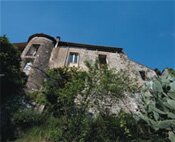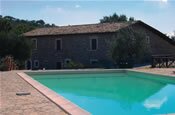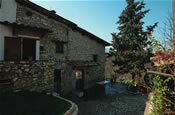Inflight Magazine of Brussels Airlines
Welcome to the Inflight Magazine of Brussels Airlines
The lure of Lazio
Competitively priced boltholes abound in the scenic medieval province of Lazio, still comparatively undiscovered by overseas buyers. Laura Henderson goes bargain hunting
 At the peak of his genius, artist Giovanni Panini bought land and a herd of sheep in the rugged Lazio hills to be assured of peace, quiet and a ready supply of pecorino romano, his favourite Lazio cheese. Fast-forward several centuries and spiralling prices in the rest of central Italy, combined with Europeans’ continuing love affair with la dolce vita, mean buyers are starting to rediscover the area, billed as “the best of central Italy without the crowds”.
At the peak of his genius, artist Giovanni Panini bought land and a herd of sheep in the rugged Lazio hills to be assured of peace, quiet and a ready supply of pecorino romano, his favourite Lazio cheese. Fast-forward several centuries and spiralling prices in the rest of central Italy, combined with Europeans’ continuing love affair with la dolce vita, mean buyers are starting to rediscover the area, billed as “the best of central Italy without the crowds”.
Surrounding Rome on the western coast of central Italy and bordered by the Apennine Mountains to the east, Lazio is a coast-and-country idyll largely untouched by the ravages of mass tourism. “Much of the region has managed to escape the Florence-today-Rome-tomorrow tourist hordes for years,” says local estate agent Emanuele Dionisi. “But that’s slowly changing, with visitors actively moving away from the central hubs to quieter outlying locales.” Italian tourist board statistics back this up. Regional investment over the past five years has led to a 40% rise in property values, although they’re still well below those of Tuscany. In the past three years, estate agents have described a mini-boom, fuelled by e-commerce and improved air links. Rome’s two airports, Ciampino and Fiumicino, now welcome more than five million visitors to the region every year. “Lazio’s edge is that it isn’t land-locked,” says Pietro Giella of Case in Italia. “And compared with Tuscany, which has reached something of a real-estate plateau, the region still has a sizeable stock of renovation opportunities at very competitive prices.”
Compact and bijou, the region’s five provinces – Frosinone, Latina, Rieti, Roma and Viterbo – cover a population of nearly five million. “Those seeking a community-style environment will be well placed here, as the population is more evenly spread out across provincial towns and villages, all of which are easy to reach,” says Dionisi. Property styles run the gamut from pristine renovated villas to habitable farmhouses with structurally sound shells to labour-of-love ruins requiring serious faux-fresco paint jobs. “A lot of our clients still want a classic Italian structure: a majestic old villa, stone farmhouse or barn with a sizable piece of land,” says Giella. “Depopulation has provided lots of opportunities to buy abandoned farmhouses at a discount.”
 Pricewise, buyers can expect to pay around €700 per square metre, rising to upwards of €2,500. While old mills and noble villas surface from time to time, casas rusticas (farmworker cottages with sloping roofs) and case coloniche (rambling farmhouses with wine cellars) are the mainstay. Top of the pile is the case padronale, a more elaborate farmhouse of two or more stories, often with wooden beams and terracotta floors. Few properties have pools, but a basic one can be installed for around €30,000. Small-bricked palazzi (renovated buildings with apartments) dominate the narrow streets of the larger towns, while rendered brick cottages and whitewashed apartments and villas are more common along the coast, with the odd custom-designed property occasionally springing up. “Most people find the architecture that bit richer inland,” confirms Giella.
Pricewise, buyers can expect to pay around €700 per square metre, rising to upwards of €2,500. While old mills and noble villas surface from time to time, casas rusticas (farmworker cottages with sloping roofs) and case coloniche (rambling farmhouses with wine cellars) are the mainstay. Top of the pile is the case padronale, a more elaborate farmhouse of two or more stories, often with wooden beams and terracotta floors. Few properties have pools, but a basic one can be installed for around €30,000. Small-bricked palazzi (renovated buildings with apartments) dominate the narrow streets of the larger towns, while rendered brick cottages and whitewashed apartments and villas are more common along the coast, with the odd custom-designed property occasionally springing up. “Most people find the architecture that bit richer inland,” confirms Giella.
It’s still early days for inward investors in the charming ‘balcony town’ of Amatrice, nestling in the Apennine Mountains in the province of Rieti, north-east Lazio. But with property prices here around 40% cheaper than those in Ascoli Piceno in the neighbouring region of Marche, it’s attracting keen interest.
“You can pick up a four-bedroom farmhouse for restoration here for just €90,000,” says Dionisi. “Spend the same again on renovation and you’ll have a valuable resale asset when the market takes off. The surrounding area has dual season appeal, with hiking and walking popular in the summer months and skiing in the winter.”
The north-west province of Viterbo has views to rival those you’d find in Tuscany and Umbria, minus the bus traffic and flag-wielding tour guides. The Etruscan and Roman towns of Tuscania, Tarquinia and Bolsena are characterised by rolling hills covered with olive groves and vineyards, and the wider area is dotted with volcanic lakes.
Restored townhouses in small villages in the region can be picked up for €150,000, and one-bedroom apartments cost around €90,000. According to Manuel Panzera of Italian Heartland, foreign buyers are increasing here thanks to easy access to Rome’s two airports, which are under two hours’ drive away, and plans for a third in Viterbo. “Also, it’s not a place mass-tourism will ever take hold,” he says.
Italian Heartland has an elegant two-bedroom townhouse on its books for €270,000, just minutes from the Pope’s Palace in Viterbo town. The terraced house was restored to a high standard in 2002, but retains many original period features such as stone arches, beamed ceilings and frescoed walls.
 While a coastal location can put a premium on prices, there are properties overlooking Lazio’s silvery-blue Tyrrhenian waters to suit all budgets. The photogenic stretch of coast south of Rome combines larger resorts such as Gaeta with boutique towns such as San Felice Circeo and Sabaudia, which cater well to the private rentals market.
While a coastal location can put a premium on prices, there are properties overlooking Lazio’s silvery-blue Tyrrhenian waters to suit all budgets. The photogenic stretch of coast south of Rome combines larger resorts such as Gaeta with boutique towns such as San Felice Circeo and Sabaudia, which cater well to the private rentals market.
Not for the faint-hearted, the high-octane summer resort of Sperlonga is famous for its steep headland, pristine wide sandy beach and lively town centre, where a good number of hotels remain open throughout winter. Property styles range from new-build studios to Liberty-style villas. “Two-bedroom apartments start at €220,000, with a small villa [250m2] fetching around €360,000,” says local agent Sara Caposatco. Rentals are also good outside the stagione [summer season], with a one-bedroom apartment netting around €450 a month.
The crème de la crème of coastal locations, the Pontine Islands off the Lazio coast, have successfully cornered the prestige market. Über-luxury villas popular with well-to-do Italians and overseas buyers easily run into the €1m-plus price bracket. The main island of Ponza – Italy’s version of the Hamptons, with its pastel-tinted houses, sleek yachts and quaint quayside restaurants – has become increasingly popular with the jet set in recent years. Thousands of glamorous young Romans hop over for wild weekends of sunbathing and dancing the night away. With fashion threatening to make a mark on the region, perhaps the best advice is to get in early while a slice of the real Lazio is still there for the taking.
Contacts
italian-heartland.co.uk
dionisi.co.uk
caseinitalia.net
FR L’attrait du Lazio
Situé juste au nord de Rome sur la côte ouest de l’Italie, bordé par les Monts Apennins et la mer adriatique, le Lazio se dessine comme un voyage idyllique entre côte et collines, sa nature étant restée largement préservée du tourisme de masse.
Compactes et somptueuses, les provinces de la région, Frosinone, Latina, Rieti, Rome et Viterbo recensent une population de près de cinq millions d’habitants. A l’intérieur, les plaines vallonnées ondulent jusqu’en Toscane, qui accueille de nombreux festivals réservés aux arts, les plaines laissent ensuite place aux lacs volcaniques de Bracciano, Vico et Bolsena. Les investisseurs européens, qui jusqu’à présent brillaient par leur absence, se joignent désormais au flux de réfugiés des paradis impayables d’Ombrie et de Toscane. Les styles de propriétés couvrent une large gamme allant des somptueuses villas rénovées, aux fermettes habitables bien charpentées en passant par les ‘chantiers de la passion’, des ruines qui réclament un sérieux travail de peinture en trompe-l’oeil.
Côté prix, les acheteurs peuvent s’attendre à payer aux alentours de €700 le mètre carré, allant jusqu’à des sommets de €2,500. Tandis que les vieux moulins et les villas patriciennes stagnent, les casas rusticas (cottages de fermier) avec toitures inclinées et les case coloniche (bâtis de fermes avec des caves à vins), constituent l’offre stable. Au-dessus de la mêlée, se démarque la case padronale – un bâtiment de ferme plus élaboré à deux étages ou plus, souvent avec des poutres en bois et des sols en terracotta. Peu sont équipés de piscines mais on peut en installer une basique pour environ €30,000. Les palazzi en petites briques (bâtiments rénovés à appartements) dominent les rues étroites des plus grandes villes, tandis que les cottages en pierres, transformés, les appartements remis à neuf et les villas sont plus répandus le long de la côte.
La crème de la crème en matière de localisation côtière sont les îles Pontine non loin de la côte du Lazio, elles se sont inscrites avec succès dans le marché immobilier de prestige avec des villas de super luxe de €1m+. A un moment où la région risque d’être envahie par l’effet de mode, le meilleur conseil est sans doute de s’y prendre tôt, tant qu’une portion du ‘vrai Lazio’ est encore à prendre …
NL Lonkend Lazio
Iets boven Rome, op de westkust van Italië en omzoomd door de Apenijnen en de Adriatische Zee, wordt de kust- en plattelandsidylle levendig gehouden door Lazio, dat grotendeels gespaard bleef van het massatoerisme.
De compacte en snoezige provincies van de streek, Frosinone, Latina, Rieti, Roma en Viterbo, bieden plaats aan bijna vijf miljoen inwoners. Landinwaarts trekken de rollende vlaktes door Toscane, de thuishaven voor tal van kunstfestivals. De vlaktes maken vervolgens plaats voor de vulkanische meren van Bracciano, Vico en Bolsena. Europese kopers, tot op heden verdacht afwezig, vervoegen nu de stroom investeerders die het peperdure Umbrië en Toscane ontvluchten. Ze kiezen er uit in hun oorspronkelijke staat gerenoveerde villa’s, bewoonbare hoeves met een gezonde structuur en ruïnes die om een liefdevolle opknapbeurt smeken.
Geïnteresseerden mogen zich verwachten aan prijskaartjes van ongeveer 700 tot meer dan 2500 euro per vierkante meter. Hoewel ook oude molens en statige villa’s hier en daar het landschap sieren, wordt het vooral getekend door casas rusticas (landarbeidershuisjes) met hellende daken en door casas coloniches (hoeves met wijnkelders). De stoet wordt aangevoerd door de casa padronale, een grotere hoeve met twee of meer verdiepingen, vaak met houten balken en terracotta vloeren. Slechts een enkeling beschikt over een zwembad, hoewel je al een eenvoudig exemplaar aanlegt voor ongeveer
30.000 euro. Palazzi (opgeknapte huizen met appartementen) met hun kleine stenen overheersen in de smalle straatjes van de grotere steden, terwijl bepleisterde huisjes en witgekalkte appartementen en villa’s een vertrouwd beeld zijn aan de kust.
Het neusje van de zalm onder de kustplaatsjes, de Pontine Eilanden voor de kust van Lazio, wist de prestigemarkt te veroveren met luxueuze villa’s waarvoor je vaak meer dan 1 miljoen euro neertelt. Met die trendy ‘stulpjes’ die hun stempel op de streek dreigen te drukken, kun je er misschien maar best haast achter zetten, nu het ‘echte Lazio’ nog aan onze voeten ligt …
Leave a Reply
